INTRODUCTION
TO
AN/FSQ-7
COMBAT DIRECTION CENTRAL
AND
AN/FSQ-8
COMBAT CONTROL CENTRAL
1 January 1959 -
15 March 1965
This document contains information of a proprietary nature. Any use or reproduction of this document for other than government purposes is subject to the prior consent of International Business Machines Corporation.
MILITARY PRODUCTS DIVISION
INTERNATIONAL BUSINESS MACHINES CORPORATION
KINGSTON, NEW YORK
Reproduction for non-military use of the information or illustrations
contained in this publication is not
permitted without specific approval of the issuing service (BuAer or USAF).
The policy for use of
classified publications is established for the Air Force in AFR 205-1 and
for the Navy in Navy
Regulations, Article 1509.
INSERT LATEST REVISED PAGES. DESTROY SUPERSEDED PAGES.
NOTE; The portion of the text affected by the current revision is indicated by a vertical rule in the left margin of a left-hand page and in the right margin of a right-hand page.
CONTENTS
LIST OF ILLUSTRATIONS
Chapter 1, Page 01
1.1 DEFINITION OF AN/FSQ-7 AND AN/FSQ-8
1.2 PURPOSE OF MANUAL
The final section of this manual introduces the related
manuals that treat the specialized technical phases of the systems
which comprise the AN/FSQ-7 Combat
Direction Central and the AN/FSQ-8 Combat Control Central.
1.3 SCOPE OF MANUAL
The final chapter lists and describes the various technical
manuals in this series, and provides a brief description of several
sources of supplementary reference material which will aid in
further study of the AN/FSQ-7 and AN/FSQ-8.
Chapter 1, Page 02
[ blank page ]
Chapter 2, Page 03
2.1 THE AIR DEFENSE PROBLEM
2.2 FORMER SYSTEM AND ITS LIMITATIONS
2.3 DEVELOPING A NEW SYSTEM
Simultaneously, studies were made on the combined use of
digital computers and radar-data transmission equipment for
application to air defense. The testing of a high-speed digital
computer was recommended to the Air Force to provide
information on the capabilities of such equipment to solve the
ever-growing problem of air defense. The findings of this program
led to many new concepts for solving the problem and resulted in
the establishment of an experimental project which gave
rise to the SAGE System. This project was developed is three
major phases: the 1953 Cape Cod System, the 1954 Cape Cod
System, and the experimental SAGE subsector.
2.3.1 1953 Cape Cod System
2.3.2 1954 Cape Cod System
2.3.3 Experimental SAGE Subsector
The experimental SAGE Subsector provides experimental
data on electronic reliability, computer pro grams, and operating
procedures. It is organized to sup. port the regular functions of a
Direction Center and is used to obtain operational approval and
to determine required equipment modifications.
2.3.4 Organizational Considerations
Chapter 2, Page 04
Staff to the Continental Air Defense Command (CONAD). The
primary concern of CONAD is the protection of retaliatory
forces, population, natural resources, and industrial potential
during initial or sustained attacks by hostile forces. This defense
must ensure successful counterattack by this country and must
also ensure the eventual successful conclusion of hostilities.
To carry out its assigned tasks, CONAD delegated certain
portions of the air defense mission to subordinate echelons. This
delegation has geographical as well as operational applications.
The Continental Air Defense Command is presently
organized into three Defense Forces, and this structure is reflected
in the SAGE System. Each Air Defense Force is composed of a
number of Air Defense Divisions. The Air Defense Division is
relieved of direct supervision of groups and squadrons. However,
its area of responsibility is large, making mandatory the
minimizing of administrative and logistic responsibilities at this
level. These responsibilities are delegated to the Air Defense
Wing.
The area for which an Air Defense Division is responsible is
normally composed of three or more sectors. The headquarters
for the division is the Combat Control Center. The Air Defense
Division exercises operational control of units designated for air
defense operations within the division and is the level at which coordination
with adjacent divisions is achieved.
The Air Defense Wing, with headquarters at the Combat
Direction Center, has subordinate units that are primarily
weapons and radars. The area of responsibility of the Air Defense
Wing is called a sector. To perform the functions of air
surveillance, identification, and weapons control, detailed
information on all defense elements is continually maintained.
2.4 DESCRIPTION OF SAGE
2.4.1 Combat Direction Center
2.4.1.1 Detection
An important characteristic of the SAGE System is its
flexibility to accept improvements in radar techniques and
equipment as they evolve. The AN/FSQ-7 and the radar-data
transmission equipments greatly reduce the time delays inherent
in data processing and permit more effective use of data from
many radars. Therefore, a large number of gap-filler radars can be
used to provide an integrated, overall air picture.
Each Direction Center controls, and is connected with, all air
defense radars that are geographically
Chapter 2, Page 05
located within the sector. These radars provide adequate radar
coverage. The air situation picture for the entire United States,
therefore, is continuously maintained by both a perimeter radar
screen and a radar umbrella. Any aircraft entering or originating in
the United States can be detected and tracked continuously.
2.4.1.2 Identification
Aircraft equipped with Mark X equipment identify
themselves automatically and do not require further action for
identification by components of the SAGE System.
The MCIS requires all aircraft entering the coastal areas of
the United States to identify themselves by means of prearranged
check words and check maneuvers, as well as to use only
predesignated corridors in
approaching the Air defense Identification Zone (ADIZ)
Flight plans are required of all military and commercial flights.
These flight plans are inserted into the
AN/FSQ-7 computers and are matched with radar returns,
continuously and automatically, to aid in identifying the spotted
aircraft. Computer programs record the number of times an aircraft
deviates from its assigned course and notify appropriate personnel
each time a deviation occurs.
2.4.1.3 Weapons Control
The air bases under the control of a Direction Center keep
the center informed of their operational status, and computer
programming indicates the number of weapons committed during
any action. In this fashion, personnel at the center are kept up to
date on the status of weapons available for assignment to targets.
Scrambled interceptors are given mid-course guidance by the
computer and are aided in their return to base by computer-generated directions.
Provisions are
Chapter 2, Page 06
Chapter 2, Page 07
made for both data links and voice channels to control
interceptors.
Point-defense weapons form the system of weapons
that supply concentrated fire-power to protect small
areas containing important targets or large, industrial,
and heavily populated areas. The present, basic point-defense
weapons are antiaircraft units and Nike missiles.
As other types of weapons become operationally
available, they may be incorporated into the SAGE System
with only minor changes required in the programming of the Direction Centers.
2.4.2 Combat Control Center
The Control Center is equipped with an AN/FSQ-8
Combat Control Central. This equipment is basically the
same as the AN/FSQ-7 Combat Direction Central, differing
primarily to the extent that some of the input
and output equipment is eliminated in the AN/FSQ-8,
since it receives no raw radar data. Also, fewer display
and drum facilities arc required at the Control Center.
The function of the Control Center in solving the
air defense problem is to combine, summarize, and display
the air battle picture for the supervision of the
several sectors within the division. (See fig. 2-3.) The
major activities with which the Combat Control Center
is concerned are:
At the same time that each Direction Center in the
division develops and displays its own picture of the air
battle in its particular sector, the data is automatically
forwarded to the Control Center. At the Control Center,
the air situation for each sector is displayed both
separately and cumulatively. In other words, the Control Center
maintains displays of the air situation in
each individual sector within the division and, at the
same time, combines the several sector air situation pictures
to present an overall picture for the entire division.
Any change in the air situations of the sectors is
reflected immediately on the displays devoted to the individual
sectors. These changes also immediately alter
the overall air situation picture for the entire division.
Thus, personnel at the Control Center are provided
with an up-to-the-minute picture of the air situation in
the area for which they are responsible (fig. 2-4).
They are in the most advantageous position to observe
developments, make decisions, and issue commands
which will be most effective in neutralizing the threat.
Should the air threat move into an adjacent area, the
adjacent Control Center may be forewarned in time to
meet the threat. In receiving the forewarning, the adjacent
Control Center receives all pertinent data concerning
the air situation with which it is apt to be faced. At
the same time, this data is forwarded to the next higher
echelon of command, which supervises the activities of
the several divisions so that the air situation, on a regional level,
may be summarized and kept up to date.
Chapter 2, Page 08
Chapter 2, Page 09
Chapter 2, Page 10
[ Blank Page ]
Chapter 3, Page 11
3.1 GENERAL DESCRIPTION
3.1.1 Combat Direction Central
The process of air defense may be broken down into a series
of related functions such as detection, identification, tracking,
weapons control, etc. To perform these functions efficiently, the
AN/FSQ-7 Combat Direction Central is capable of assembling
large quantities of diverse information from many sources. This
information includes radar data, commercial and military aircraft
flight plans, and weather data. The Viral f is also capable of
processing data to identify and track all aircraft, friend or foe. The
AN/FSQ-7 also directs antiaircraft batteries-,and all interceptors,
manned or remote-controlled; to positions close enough to the
target for the interceptor itself to complete the interception. In
addition, the AN/FSQ-7 keeps all personnel fully informed about
the air situation, alerts them to actions required, displays possible
recourses for action, and continually computes and displays all
subsequent changes to the original data.
3.1.2 Combat Control Central
The functions of the Control Central are largely supervisory
in nature. Personnel at this echelon of command are responsible
(1) for monitoring the action in each of the sectors comprising the
division and (2) for making decisions relating to the allocation of
weapons. In addition, personnel at the Control Central are responsible
for co-ordination with other Control Centrals and for
presenting the divisional air situation to higher echelons of
command.
3.2 SYSTEM BREAKDOWN
The first five systems listed above are integral part: of the
data-processing operations of the AN/FSQ-7 and the AN/FSQ-8
and execute functions within themselves which contribute to the
overall operational solution of the air defense problem. The two
latter systems listed above are not directly concerned with the
defense functions of either Central.
For purposes of uniformity in design, production and
maintenance, the AN/FSQ-8 equipment installed at the Control
Center is almost identical to its counterpart the AN/FSQ-7 at the
Direction Center. However, because of functional differences,
certain portions of the equipment at the Control Center are either made inoperative or
entirely omitted.
The Combat Control Central requires fewer operating
personnel and has fewer display consoles than the Combat
Direction Central. The Combat Control Central does not process
raw radar data; therefore, the equipment required for receiving
and processing radar data is unnecessary at these installations.
Likewise, the amount of manual data input equipment is reduced.
It follows logically that the computing capacity of the AN/FSQ-8
will not be as heavily committed as that of the AN/FSQ-7.
Therefore, the Combat Control Central is able to assume
additional activities in the future as the needs arise.
Chapter 3, Page 12
The discussion of the various systems in this manual is
brief, general, and designed merely to acquaint the reader with the
overall functions of the systems. For a complete detailed
discussion of the various systems, the reader is directed to the
related manuals devoted specifically to the various systems.
These manuals are identified in Chapter 5.
3.2.1 Input System
The Input System comprises four elements (fig. 3.2),
which are named for the types of input data they process:
Input data to the AN/FSQ-7 is transmitted automatically,
from radar equipment. XTL information from other Centers is
also sent automatically. Certain air surveillance, status, and other
data received sporadically or at an extremely slow rate can be
inserted manually into the machine. This slow-changing data is
received at the Direction Center by voice telephone or by
manually operated teletype equipment, processed by MDI
operators, and inserted into the AN/FSQ-7 through card
machines.
The XTL element automatically receives and processes
digital data from the AN/FSQ-7 Combat Direction
Centrals that are within the jurisdiction of the Combat Control
Central and, also, from other Combat Control Centrals. The MDI
element processes relatively slowspeed, low-priority input data
from within the Central and is the means by which human
commands and decisions are introduced into the computer.
In addition to the four input elements, the Input System is
also equipped with a test pattern generator (TPG), used for input
channel testing, and the simplex maintenance console in which the
control panels for the channels of the input elements and the TPG
are mounted.
The Input System at an AN/FSQ-8 Combat Control Central
is composed of only two major elements, the XTL element and
the MDI element. The TPG and the simplex maintenance console
are employed in the AN/ FSQ-8 in exactly the same manner as in
the AN/FSQ-7.
3.2.1.1 Gap-Filler Input Element
A radar-mapping technique employing a plan position
indicator (PPI), a mask, and a photocell removes areas of
unwanted data, such as ground clutter, from the system. A
mapper console displays all radar returns on a PPI presentation,
allowing an operator to evaluate
the target indications and to eliminate those that are undesirable.
Chapter 3, Page 13
Each target appears on the mapper console cathode-ray tube
screen as a blue flash followed by a long persistent yellow glow. A
photomultiplier tube with a filter, mounted above the screen,
generates mapped target pulses from the blue flashes only. The
operator, by painting a liquid which is opaque to blue light over
unwanted targets, prevents their presentation to the computer.
The operator can see the yellow glow, but the photomultiplier
tube cannot detect the blue flash through the filter and the
mapping liquid.
The GFI drum acts as a reservoir for gap-filler radar data.
This data is stored in the drum until requested by the computer.
Chapter 3, Page 14
3.2.1.2 Long-Range Radar Input Element
The LRI drum stores FGD, Mark X, and heightfinder
messages until the computer is ready to use them.
3.2.1.3 Crosstell Element
In the strict sense of the word, the term crosstell refers only
to the exchange of information between Centrals of equal
command; i.e., between AN/FSQ-7 Combat Direction Centrals or
between AN/FSQ-8 Combat Control Centrals. The XTL element
of the Input System in the Combat Control Central, however,
also receives information from the subordinate Combat Direction
Centrals. This operation (from Direction Central to Control
Central) is called forwardtelling and is distinguished from
crosstelling. However, since both crosstold messages from other
Control Centrals and forwardtold messages from Direction
Centrals are accepted by the XTL element of the Control Central,
both are considered to be the same for purposes of discussion in
this chapter.
3.2.1.4 Manual Data Input Element
The overall function of the MDI element is to process input
data which is manually introduced into the machine. This data
includes four general categories of information:
To process these various inputs, the MDI element is
divided into two sections, each with its own particular functions.
These two sections are the drum entry section and the direct
entry section. Due to the disparity in the speeds of assembling
messages, each of the two sections processes data originating
from different sources.
3.2.1.5 Simplex Maintenance Console
3.2.1.6 Test Pattern Generator
The test pattern generator is capable of being operated
either by manual control alone or by both manual control and
computer control together. Messages can be initiated, terminated,
or continuously repeated under either manual or manual-computer
control. During certain operations, the TPG is under
complete manual control, the messages being composed, initiated,
and terminated by manually set switches. During certain other
operations, the messages are composed manually but are initiated
by instructional pulses sent out by the Central Computer.
3.2.2 Drum System
********* pages 15 and 16 were recovered from microfilm,
and a bit noisey ********
Chapter 3, Page 15
Chapter 3, Page 16
>
The Drum System is composed of six main drums and six auxiliary drums. All drums
are identified by names based on their functions in relation to other systems.
The six main drums are designated as follows: the LOG drum, the MIXD drum,
the RD drum, the TD drum, the AM-A drum, and the AM-B drum. The letters used
in the designations are the initial letters of the equipments which they serve.
For example, the LOG drum handles the transfer of data to and from the LRI
(long-range radar input), OB (output buffer), and GFI (gap-filler radar input)
elements of the Central. Likewise the MIXD drum is concerned with the MDI
(manual data inputs), IC (intercommunication), XTL (crosstell), and DD (digital display) elements. The RD transfers radar data, while the TD drum accommodates track displays.
The AM-A and AM-B drums are auxiliary memory (AM) drums A and B.
The data accommodated by each drum is assigned to logical drum divisions known
as fields. The main drums have a total of 39 fields, 9 fields on the RD drum
and 6 fields on each of the other drums. Of these fields, three (LRI. GFI, and RD)
are not utilized in the functional operations of the AN/FSQ-8 Combat Control Central,
because the Control Central is not involved in processing the raw radar data to
which these fields are devoted in the Direction Central. Consequently, these
drum fields are available for use as auxiliary storage devices at the Control Central.
3.2.2.1 Main Drums
The primary functions of the main drums are to serve as temporary storage devices
for the transfer of information to and from the Central Computer and to discharge
this information at speeds compatible with the surrounding systems. The drums are
capable of storing information as long as necessary. Information is written into
and read out of the drums without alteration. Tactical data introduced into the
Drum System from the Input System for transfer to the Central Computer System
arrives at random intervals in large quantities. The drums store this data until
it is requested by the Central Computer System Tactical information that has been
processed by the Central Computer System is written onto the drums at a high rate
of speed, stored temporarily, and then read off to other systems at speeds compatible
with their operations.
Since the access time to data stored on drums is longer than that of data stored
in computer memory, the computer transfers large blocks of information from drums
to core memory before they will be needed. Thus, the high speed of computer
arithmetic operations is not retarded. Besides functioning as storage devices,
the main drums generate timing pulses for use by the Input, Output, and
Display Systems. These timing pulses synchronize the joint operations of the
drums with the systems named above during the transfer of data. When data transfers
are not in process, these same systems utilize drum timing pulses to control their
own internal operations.
In addition, the Drum System stores intercommunication data for transfer to
the standby Drum System and standby Central Computer System (4.3.1). When
Chapter 3, Page 17
maintenance operations are to be performed on the active Drum
and Central Computer Systems, the operations of the active
systems are switched to the systems that have been in a standby
status. To shorten the time consumed in the transfer of data,
intercommunication between the active and standby systems is
maintained constantly. As a result, the standby equipment is kept
as up to date as possible with the operations of the active
equipment. Another use for the intercommunication function is
that it enables the standby computer to check the operations of
the active computer while they are being performed.
3.2.2.2 Auxiliary Drums
As an auxiliary memory, the Drum System can store
information indefinitely. The drums performing this function are
accessible only to the Central Computer System, since the other
systems have no need of auxiliary storage facilities. Computer
programs, subprograms, tables of reference data, etc., are the
types of data most generally stored on the auxiliary drums.
Central Computer System programs and subprograms, for
the most part, are too extensive to be stored entirely in the
memory of the Central Computer System; therefore, additional
storage space is provided in the Drum System. The access time of
data stored on drums, while slower than the access time of data
stored in computer memory, is appreciably faster than the access
time of data stored on card and tape machines. The drums,
therefore, fulfill the requirements of storage capacity at a medium
access time.
3.2.3 Central Computer System
The Central Computer is capable of adding, subtracting,
multiplying, and dividing. More complicated
operations such as extracting square roots and evaluating complex
variables can be performed by combining the basic arithmetic
operations. The computer is designed to respond to simple
stereotype instructions, each of which causes the computer to
perform a single arithmetic operation. An extended sequence of
such instructions, resulting in the solution to a problem, is called
a program.
When solving any given problem, the Central Computer
actually uses only the addition process, reducing all other
processes to types of addition. This is more easily accomplished
in a computer by utilizing the binary
rather than the decimal number system. The binary system is
based on a 1 or 0 (yes or no) principle and, consequently, requires
circuits with two stable conditions to indicate a 1 or a 0. The
decimal system, involving 10 digits (0 to 9) would require circuits
with 10 stable conditions.
The function of the Central Computer System is to process
algebraically and logically the military tactical data supplied to it
by the Input System via the Drum System, transferring the
results back to the Drum System for subsequent distribution to
the Display and Output Systems.
In addition to processing data, the Central Computer
System operates as the main control for the Central. As data is
being processed, the Central Computer generates signals, as
instructed, and sends them to the Drum System for utilization by
the Input, Display, and Output Systems. These signals control
the flow of data between systems, initiate operational cycles, set
up control circuits for the coming operations and, in general.
synchronize the actions of each system with those of the Central
Computer System.
Functionally, the Central Computer System is divided
into seven groups:
The instruction, selection, and program control elements
sequence, co-ordinate, and control all processes in or allied
with the operation of the computer. The entire instruction
control element and a part of the program control element govern
internal computer operations, while the selection control element
and the remaining part of the program control element govern
external computer operations primarily connected with 10
devices.
Chapter 3, Page 18
The arithmetic element performs arithmetic processes using
numerical data as instructed by the program. The associated 10
units are commercial IBM machines modified for use with the
computer and are not to be confused with the Input and Output
Systems of the Central. The manual control facilities enable
personnel to start, operate, shut down, and service the computer.
3.2.3.1 Instruction Control Element
3.2.3.2 Selection Control Element
The selection control element synchronizes, controls, and
directs data being transferred between the computer memory
element and the several IO units including the Drum System.
Prepared instructions, set ting up control circuits in the selection
control element must be performed in advance of the actual
transfer of information. This enables the information transfer t<
be properly initiated and processed.
The selection control element also incorporate: circuits
which permit the Central Computer, directed by a specific
program, to perform certain operations affecting the
electromechanical units allied with the 10 units and the several
other electromechanical units in
the system. In addition, the selection control element determines
existing conditions in the Central and directs the operations of the
computer accordingly.
Chapter 3, Page 19
3.2.3.3 Program Control Element
The program control element, in order to procure specific
instructions, controls the selection of internal storage devices and
such information as may be required by an instruction. In
addition, the program element sequences the transfer of each
instruction stepped out of the internal storage devices at the
proper moment.
In guiding the processing of information, the program
element co-operates with other elements of the computer. The
instruction control and program elements together sequence and
control the internal information-processing operations. The
program and selection control elements together co-ordinate and
effect the external transfer of information between the computer
and other systems of the Central. The program element,
therefore, contains circuits associated both with the internal
control operations of the instruction control element and with the
external control operations of the selection control element.
3.2.3.4 Arithmetic Element
Primarily, the arithmetic element employs the four basic
arithmetic operations (addition, subtraction, multiplication,
division) in the performance of its functions. Operands for the
calculating processes are obtained from the computer memory
element. The setting up of arithmetic operations is governed by
add-class and multiply-class instructions which provide
command pulses from the instruction control element. The result
of the calculations is either retained in the arithmetic element for
further processing or transferred to the memory element for
storage until required by a subsequent program.
3.2.3.5 Internal Storage Devices
There are two core memory elements contained in the
computer. These elements are high-speed storage devices that are
able to store and facilitate rapid access
to thousands of binary words. Each of the core memory elements
is divided into three units: a left memory unit. a core memory
array unit, and a right memory unit. Both memory units are
composed of equipment associated with the transfer of
information between the core memory elements and other
systems as well as the computer itself. The core memory units
are composed of actual arrays of ferrite cores in which
information is stored.
The test memory is composed of 19 registers and other
equipment associated with the transfer of information between
the test memory and the computer Physically, certain portions
of the test memory are located in two separate units. The
plugboard control panel and the control switches are located on
the duplex maintenance console, and the addressing and readout
control circuits are located in the left arithmetic unit.
3.2.3.6 Input-Output Devices
An input device associated with the computer may be
defined as a unit which transmits data directly into the computer.
An output device is a unit which receive data directly from the
computer. Certain units, because of the nature of their functions,
may be considered a; being both input and output devices. The
Input System and the Output System do not deal directly with
the computer, as the data for these Systems must first pass
through the Drum System.
3.2.3.7 Manual Controls and Computer Indicators
The duplex maintenance console contains the majority of
the controls and indicators for the manual operation of the
Central Computer System. The alarm and neon indicators on the
console show the status of the computer, and virtually all
manual program and checking operations are affected by means
of the con sole controls.
Chapter 3, Page 20
The duplex switching console is used by maintenance
personnel to establish the status, active or standby, of the
separate sets of duplex equipment. Each computer transfers
status data to the duplex switching console. This data activates
indicators and alarms, permitting maintenance personnel to
determine the operating condition of each computer and to make
quick decisions pertaining to duplex switching operations.
3.2.4 Display System
Information processed by the computer is sent via the
display drum fields to the Display System, where it is converted
as required and presented on cathode-ray tube (CRT) displays to
the operators of the. Figure 3-6 shows the Display System, the
associated drums, and the tie-ins to the MDI element.
The equipment contained in the Display System, for
purposes of this discussion, is divided into the following major
groups: the digital displays, the situation displays, and associated
equipment. The digital and situation displays are made up of
consoles housing CRT's which present a picture of the air
situation to an observer. The associated equipment is made up
primarily of various components connected with the operational
functions of the displays.
The Display System provides the means by which the air
situation of the area supervised by the Center is visually
presented to human observers. This is accomplished by means of
special CRT's mounted in specially constructed and equipped
consoles.
Data is first accepted by the Input System and is
subsequently transferred to the Display System via the Drum and
Central Computer Systems. The tracks and raids representing the
air situation are consolidated and converted into larger common co-
ordinates for display at the consoles. Since all such data is
received from the computer in binary form, the Display System
converts the data from the binary form to a system of letters,
numerals, vectors, and symbols. This conversion permits the
presentation of a display which is more readily viewed and
interpreted by the observer.
The console operator observing the air situation messages
presented on the CRT may act on the information in several
ways. The operator may communicate with the computer by
requesting information from the computer, or by feeding back
information in answer to
a request from the computer. He may instruct the equipment
to transfer a message to the console of another
operator. These operations are possible through the use
of manual-intervention switches and light guns located
on the consoles. Telephone facilities located at the console
are also available to the operator for communication
with other personnel within the Center He may
also communicate beyond the area of the Center by wire
and radio telephone circuits.
The Display System employs two basic types of CRT
displays for presenting the visualized air situation to the human
observer. They are the digital displays and the situation displays.
The CRT's for these displays are mounted in various types of
display consoles located at selected operating positions in the
Center. Typical consoles are equipped with a situation display
(SD) scope, a digital display (DD) scope, and various manual-
intervention (MI) switches, alarms, and warning lights. Many
consoles are also equipped with a light gun and telephone
facilities (fig. 3-7).
In addition to the display consoles, the equipment of the
Display System encompasses various types of associated
equipment, including auxiliary consoles (fig. 3-8), which aid the
Display System in the performance of its functions.
3.2.4.1 Digital Displays
Digital display data is processed by the computer and
transferred in binary form via the Drum System to the Display
System. Since data in binary form is difficult for an observer to
interpret, the binary information is converted to analog voltages
which, in turn, are converted to the visual display presented on
the face of the DD CRT.
3.2.4.2 Situation Displays
Chapter 3, Page 21
Chapter 3, Page 22
The 19-inch CRT used for the situation display is not a
conventional-type tube. It is a large, special-purpose tube which
is capable of generating complete individual characters, drawing
vectors, assembling the characters and vectors into message
patterns, and positioning the entire message pattern in the proper
place on the screen of the tube. The result viewed by the
observer is an orderly arrangement of message patterns, each
message consisting either of a single character m4 a group of
characters.
All SD messages are rewritten on the face of the CRT at
short, regular intervals. If the basic data has not changed or been
superseded, the display is continually repeated in the same
position. If, on the other hand. the
information has changed, the display is corrected. It this way, the
console operator is presented with air situation changes within an
extremely short time after they occur.
3.2.4.3 Associated Equipment
Chapter 3, Page 23
The associated equipment is connected with the situation
displays and the digital displays either physically, optically, or
by signal flow. The situation display consoles, for example,
provide the housing for the tubes and the devices needed to
control their operations. Certain displays are equipped with either
an SD camera element or with a photographic recorder-reproducer
(PRR) element (optical connection). Since it
sends signals to the Display System, the display tester element
(DTE) a connected to the displays by signal flow.
3.2.5 Output System
The Output System transfers tactical information from the
Center to other air defense installations. Having formulated an
output message, the Central Computer System transfers the
message to the output buffer (OB)
fields of the LOG drum in the Drum System. The Output System
then accepts the message from the OB fields and transfers it to
the appropriate telephone terminal equipment for transmission to
its destination.
3.2.5.1 Output Messages
Output messages transmitted from one Center to other
centers at the same echelon of command are known as crosstell
messages. Thus, messages from one AN/FSQ-7 to other
AN/FSQ-7's, and from one AN/ FSQ-8 to other AN/FSQ-8's, fall
into this category. The
Chapter 3, Page 24
messages are composed by the computer and sent via the Drum
System to the Output System for automatic transmission to
adjacent Centers over automatic (G/G) party-line telephone lines.
Backtell messages are those communications that are
transmitted to facilities at subordinate echelons of command.
Thus, a message from an AN/FSQ-7 to a radar site, for example,
would be a backtell message. In the same sense, a message from
an AN/FSQ-8 to an AN/FSQ-7 would also be a backtell message.
At the AN/FSQ-8, however, backtell messages are presently
carried over voice telephone lines only and therefore are not a
function of the Output System.
Output messages which relay tactical information to higher
echelons of command are known as forwardtell messages.
Teletype equipment is one means of communicating with higher
echelons not equipped with AN/FSQ-7 Combat Direction Centrals
or AN/FSQ-8 Combat Control Centrals.
3.2.5.2 Output Control Element
Chapter 3, Page 25
3.2.5.3 Output Storage Element
The G/A-FD and G/A-TD storage sections receive and
temporarily store output messages that are to be sent from the
Center to manned interceptors. This storage section transfers
such messages to the telephone terminal equipment utilized in
relaying messages to automatic, radio, data-link transmitters and
thence to the interceptors.
The BOMARC 1 and BOMARC 2 storage sections receive
and temporarily store output messages intended for guided
missiles. The transfer of such data to its final destination takes
place in the same manner as for G/A messages.
The G/G storage section receives and temporarily stores
output messages that will be sent to other Centers. It transfers
these messages to the telephone terminal equipment utilized in
transmitting information to sites that have automatic input
equipment.
The TTY storage section receives and stores output
messages that will be transmitted to higher echelons or to remote
nonautomatic sites. It transfers these messages to telegraph
terminal equipment used to send output data to installations
equipped with teletype receivers.
3.3 PHYSICAL DESCRIPTION
3.3.1 Direction Center
A typical floor plan of the original Direction Center
is shown in figure 3-12. The associated power and air-conditioning
equipment building (fig. 3-12) is a 1-story structure,
110 feet square, and approximately 21 feet high. It is connected
to the Direction Center by a 22-by-100-foot bay that provides
for storage and maintenance space, including a throughway for
steam, water, and power lines. Adequate fuel storage is provided
for the operation of the power plant.
Typical support facility requirements for a Direction
Center are:
3.3.2 Control Center
3.3.3 Combined Direction Center-Control Center
The power and air-conditioning plant is a stepped. 1-story
building 220 feet by 150 feet, half of which is approximately 25
feet high, and the other half of which is approximately 15 feet
high. It is located near the Operations Building. A covered
passage for cables and piping connects the two buildings (fig. 3-15).
Fuel storage and support facilities for the DC-CC site are
the same as those described for the DC and CC sites.
Chapter 3, Page 26
Chapter 3, Page 27
Chapter 3, Page 28
Chapter 3, Page 29
Chapter 3, Page 30
Chapter 3, Page 31
Chapter 3, Page 32
Chapter 3, Page 33
Chapter 3, Page 34
Chapter 4, Page 35
4.1 RELIABILITY DEFINED
Both the AN/FSQ-7 Combat Direction Central and the
AN/FSQ-8 Combat Control Central utilize tens of thousands of
electron tubes and associated circuitry. Of these, more than half
are processing air defense data at any given time. To assure
continuous functioning of both Direction Central and Control
Central, the following precautions are incorporated into each as
basic features:
Because of the physical nature of the equipment and the
importance of its function, the requirements for optimum
reliability cannot be over-emphasized. It is one thing to develop
equipment designed to solve the problems of air defense. It is
something else again to be able to rely on that equipment for
continuous operation with accurate results. The security of the
nation demands that the SAGE System, in all its aspects, be
unerringly reliable.
4.2 MAINTENANCE REQUIREMENTS
Error detection by the use of programs has distinct
advantages. A program can be changed easily when the computer
or any auxiliary components are changed. A
program can be constantly improved. No extra equipment is
required since the program uses the facilities that are already
available. A program uses the machine in a more normal manner
than does test equipment. A program that has been checked and
accepted as a good maintenance tool is not subject to
deterioration. B3 contrast, standard test equipment may be
checked and accepted only to become unreliable shortly after
being placed in actual use.
Maintenance programs are divided into two main classes,
reliability programs and diagnostic programs. Maintenance
programs used to detect the existence of errors are called
reliability programs. A reliability program checks all or part of
the computer for correct operation. Maintenance programs used
to isolate machine failures known to exist are called diagnostic
pro grams. A diagnostic program locates the machine fault as
closely as possible.
4.3 EQUIPMENT APPROACH
4.3.1 Duplexing
Duplexing equipment makes it possible for one machine
(called the standby machine) to be maintained in perfect
condition without cessation in normal operations since its twin
(called the active machine) is under. taking the processing of air
defense data (fig. 4-1) Should a breakdown occur in the active
machine, the standby machine takes over operations (thus
becoming active), with the malfunctioning active machine now
becoming the standby. The only delay encountered it this
switchover would be met if the standby machine
Chapter 4, Page 36
were undergoing corrective or scheduled maintenance. Such delay,
however, would be very short.
In instances where the standby machine is operable when
the active machine breaks down, no delay is encountered in
switchover. Also, little or no information is lost, because the
standby machine normally receives the same data as the active
machine. (Figure 4-2 shows an outline of a typical, duplexed
Central.) While the active computer is carrying out normal
defense tasks, the standby computer runs a special program to
store the data necessary to take over operations from the active
computer. The standby computer also uses the program to check
itself for optimum operating condition, to monitor the operation
of the active computer, and to assist in the maintenance of
equipment not in use.
Duplexing, therefore, is the arrangement whereby certain
equipment is installed in duplicate to preclude the shutdown of
the Central during correction of
malfunction. Equipment that is not of such a critical nature - the
failure of which would not render the Central inoperative-is
known as simplex equipment No duplicates of these equipments
are installed, as the Central is capable of operating without them.
4.3.2 Built-In Test Circuitry
Marginal checking (MC) is the method used to detect
imminent circuit failures. The circuits are designed so that one or
more of their associated supply voltage may be varied in
prescribed amounts without causing circuit failure when the
components are within accepted tolerances. Components outside
of accepted tolerance require less voltage variation than normal to
cause failure. Therefore, component deterioration can be detected
by the amount of voltage variation required to cause failure. The
voltage variation which causes
circuit to fail is called the circuit margin. Marginal checking is not
a maintenance tool, however, unless used with programs which
operate the circuit to which the MC voltage excursions are
applied.
The MC System serves to vary the MC voltages one at a
time, over large sections of the system. For a more detailed
reliability check, a breakdown of these large circuit groups is
made on the expected circuit margins. A further breakdown is
provided for the purposes of fault isolation in the event of a
failure during a reliability test.
4.3.3 Special Test Equipment
Test equipment is located in the maintenance and test area
of the Central. Maintenance parts and special: tools are provided
in the adjacent parts storage area.
To prevent power interruptions in the maintenance and test
area from interfering with normal operation of the Central, the
maintenance and test area is provided with its own independent
power supply. This power supply provides power only for the
special test equipment located at the Central.
Chapter 4, Page 37
Chapter 4, Page 38
[ page 38 is blank ]
Chapter 5, Page 39
5.1 PHILOSOPHY OF ORGANIZATION
The organization of manuals for the AN/FSQ-7 and
AN/FSQ-8 equipments is directly related to the divisions
outlined above. Information concerning functional systems of the
equipment can best be understood when compiled in manuals
organized about logical divisions. On the other hand, installation,
operation, maintenance parts listings (of physical groups), and
special test equipment information can best be understood when
compiled by physical divisions.
The manuals are structured to permit the reader to assimilate
information in successively finer detail. Manuals not directly
related to the equipment (theory) are organized to give the reader
opportunity to stop at certain points in a manual and how the
complete subject to a degree governed by the place at which he
stops. This is possible because the divisions of the manuals are
functionally complete and enable the reader to thoroughly
understand the equipment, unit, element, etc. being discussed.
5.2 TYPES OF MANUALS
5.2.1 Theory Manuals
5.2.1.1 Introduction Manual
5.2.1.2 Theory of Programming Manual
5.2.1.3 Basic Circuits Manual
CHAPTER 1
INTRODUCTION
CHAPTER 2
EVOLUTION OF SAGE SYSTEM

Figure 2-1. Relationship of SAGE to the Air Defense System
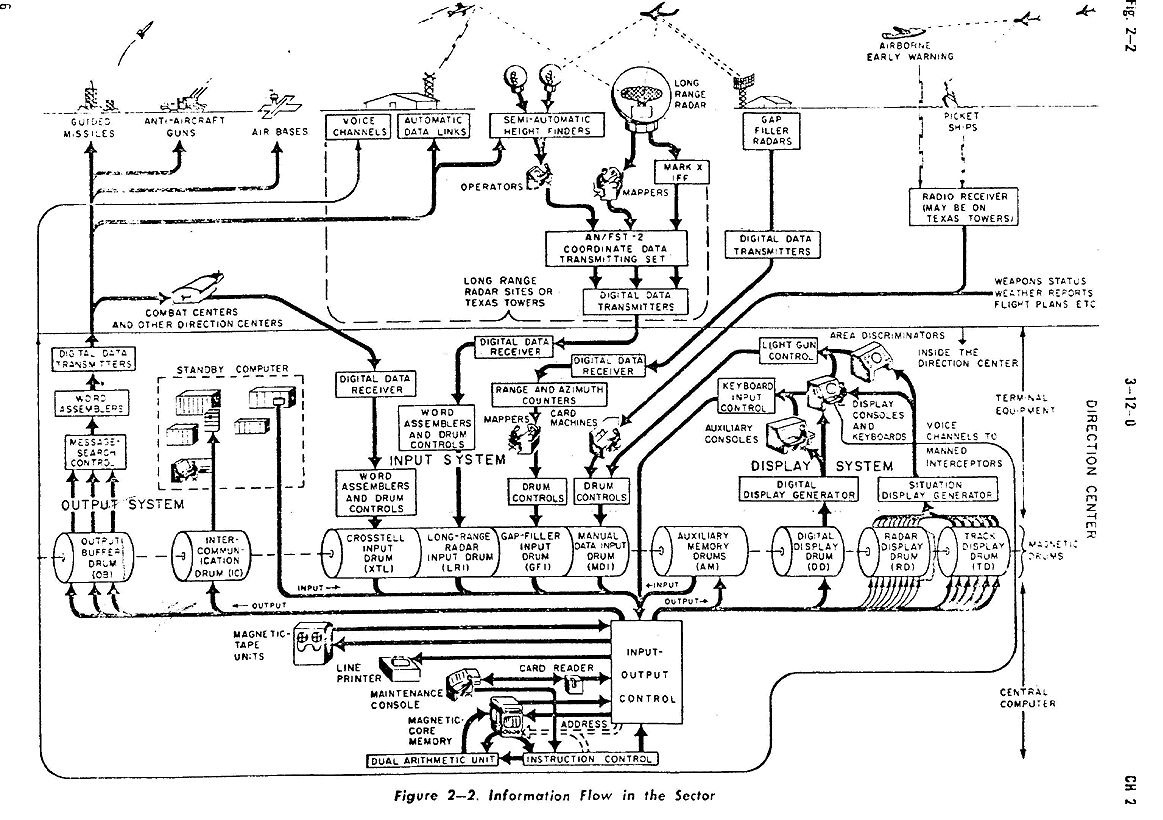

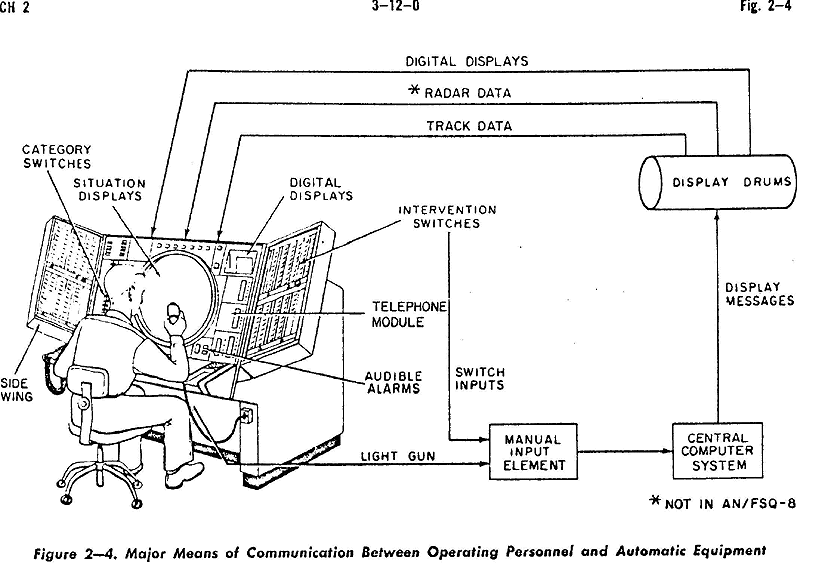
CHAPTER 3
DESCRIPTION OF AN/FSQ-7 AND AN/FSQ-8

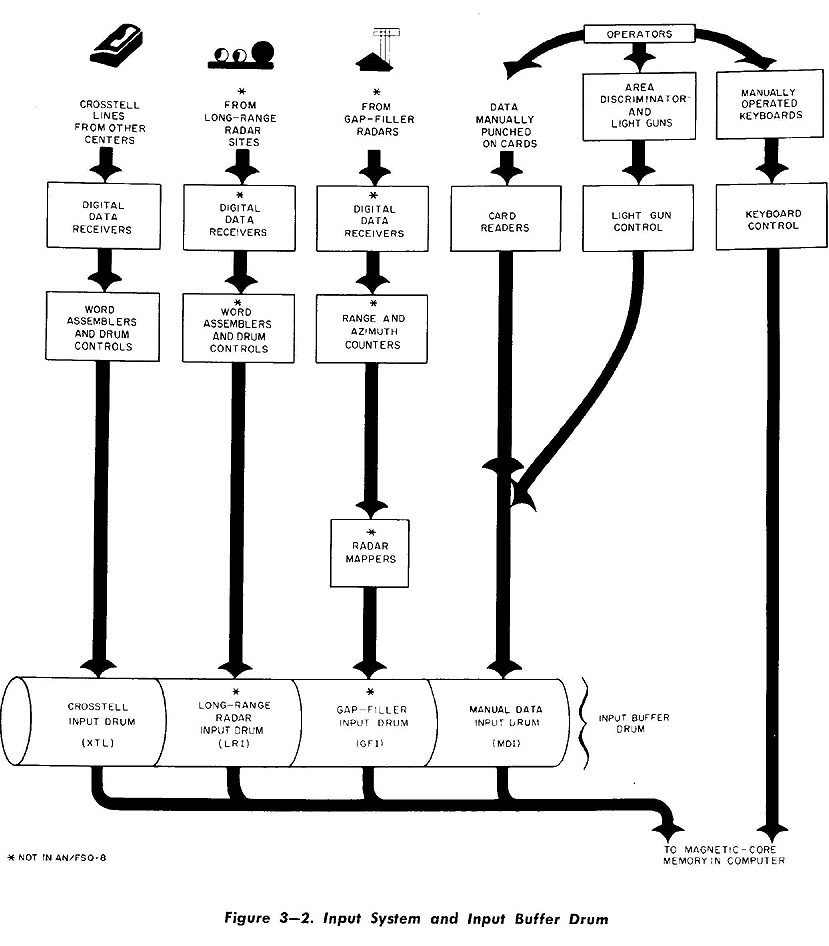
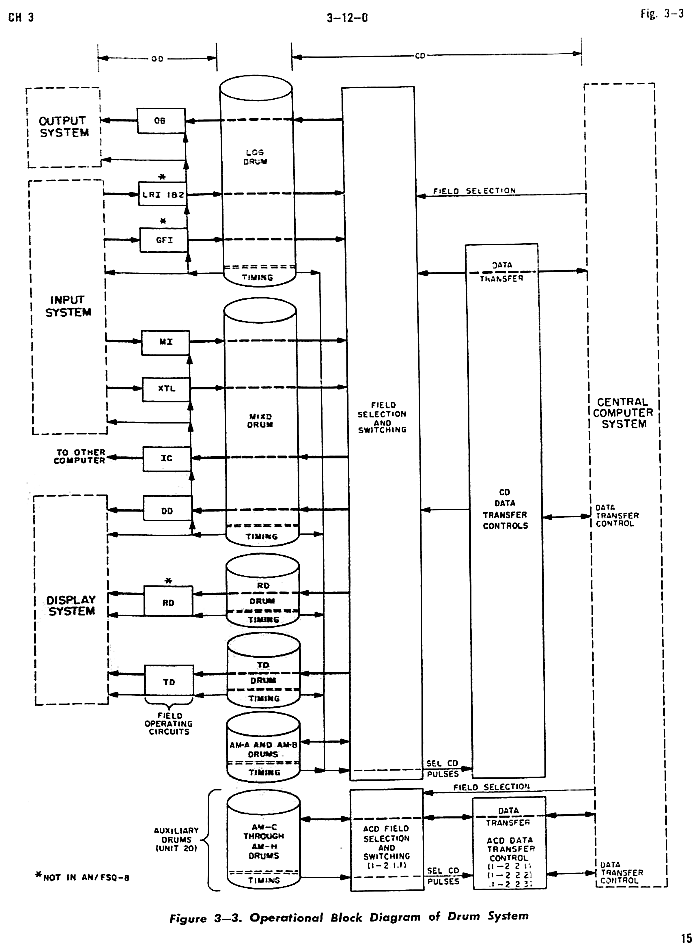
Main Drums 311-31Z I
3-12-11
CH 3
and transfer circuitry. performs two important functions. It acts as a time buffer
storage system between the Central Computer System and the Input. Output,
and Display Systems. and it am as an auxiliary memory for the computer.
During normal operation of the Central, the Drum System handles most of the
information being passed between the other systems but in no way alters this
information. (As a storage device, it performs no computations.)
 <
<
The operations of the main drums may be separated into two major categories:
the operations involved in the exchange of information with the Central Computer
System and the operations involved in the exchange of information with the other
systems. Information transfers between the main drums and the Central Computer System
are known as CD (computer-to-drum) operations. Information exchanges with other
systems are known as OD (other-than-computer-to-drum) operations (fig. 3-4).
a. Instruction control element
b. Selection control element
c. Program control element
d. Arithmetic element
e. Internal storage devices
f. Associated IO units
g. Manual controls and computer indicators
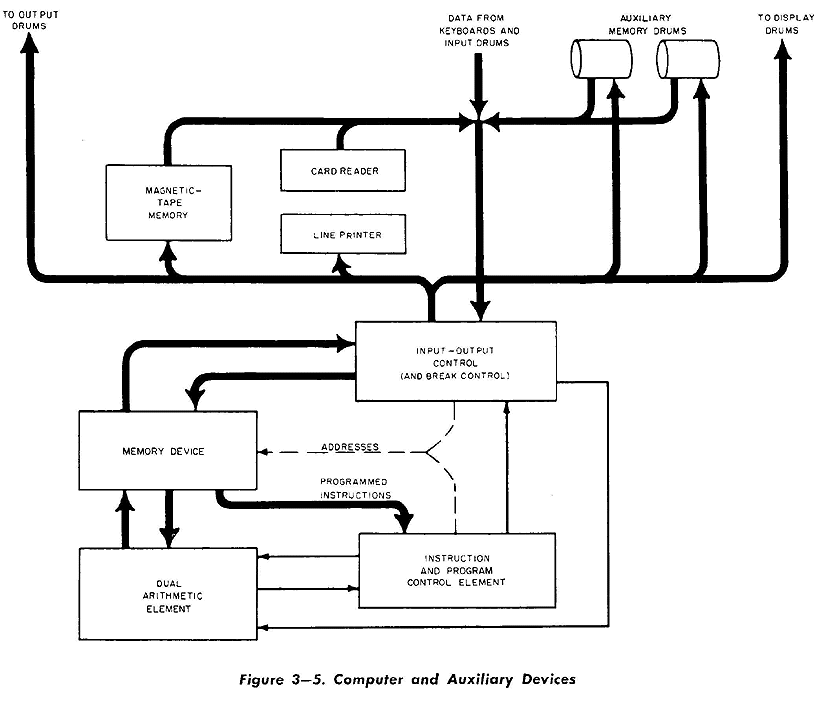

Figure 3-6. Display System and Display Drums

These two elements perform all functions of the Output
System. In performing these functions, the Output System relies
to a great degree, as do the other systems of the Central, on
certain facilities of the Drum System.
The messages may be grouped into one of three categories,
depending on the intended destination of the message; that is,
into crosstell, back tell, and forwardtell messages.


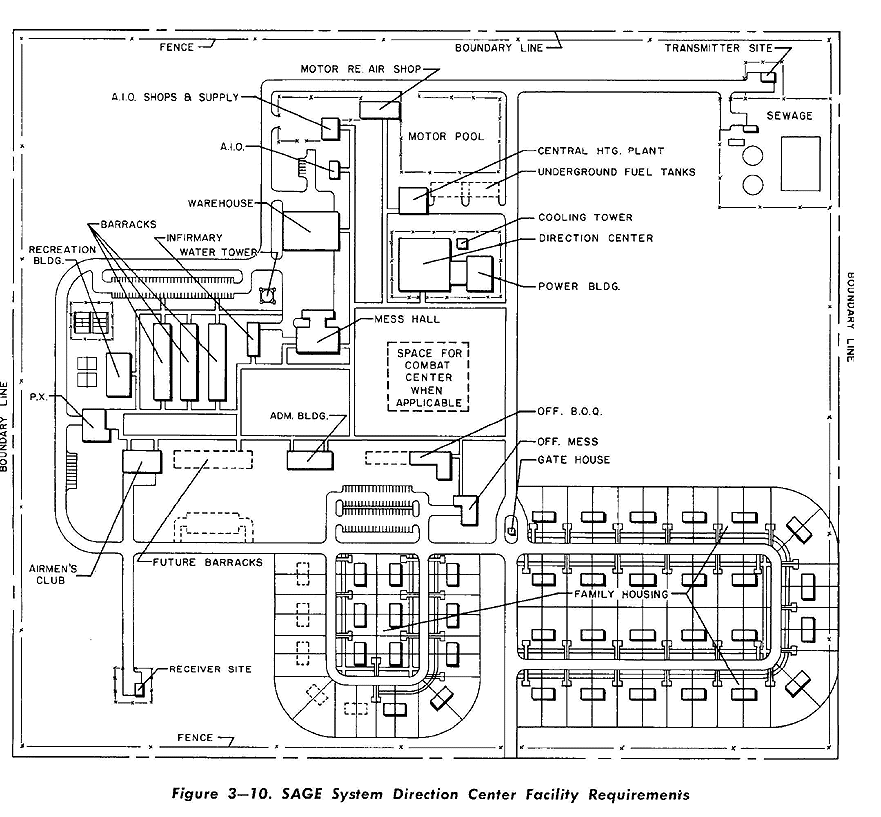

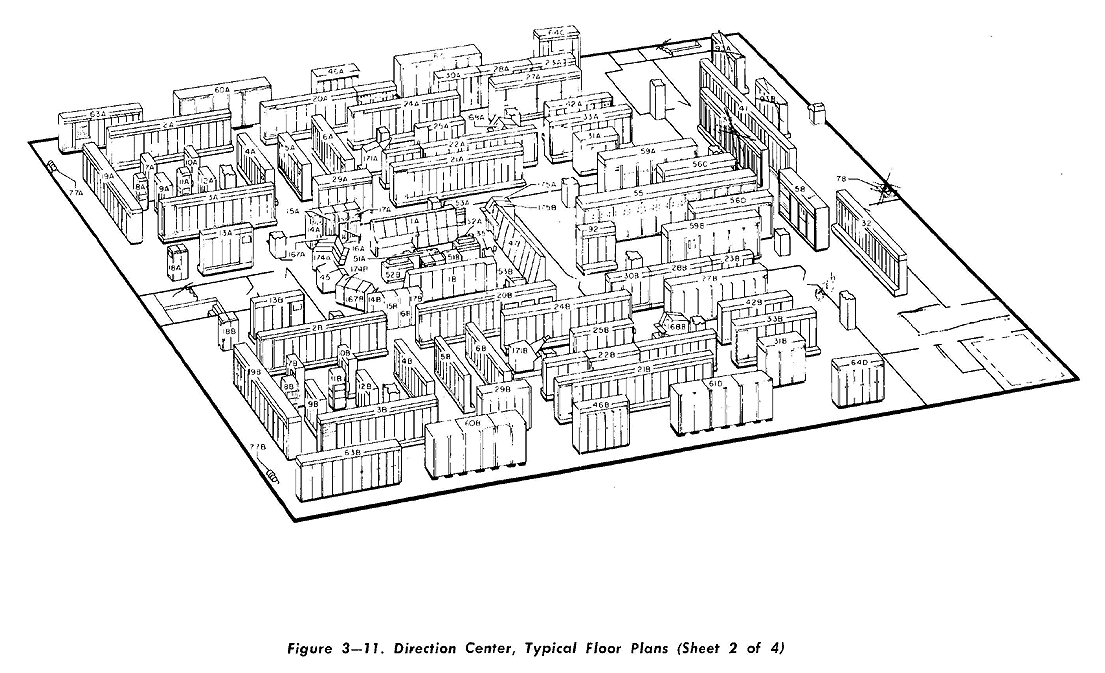
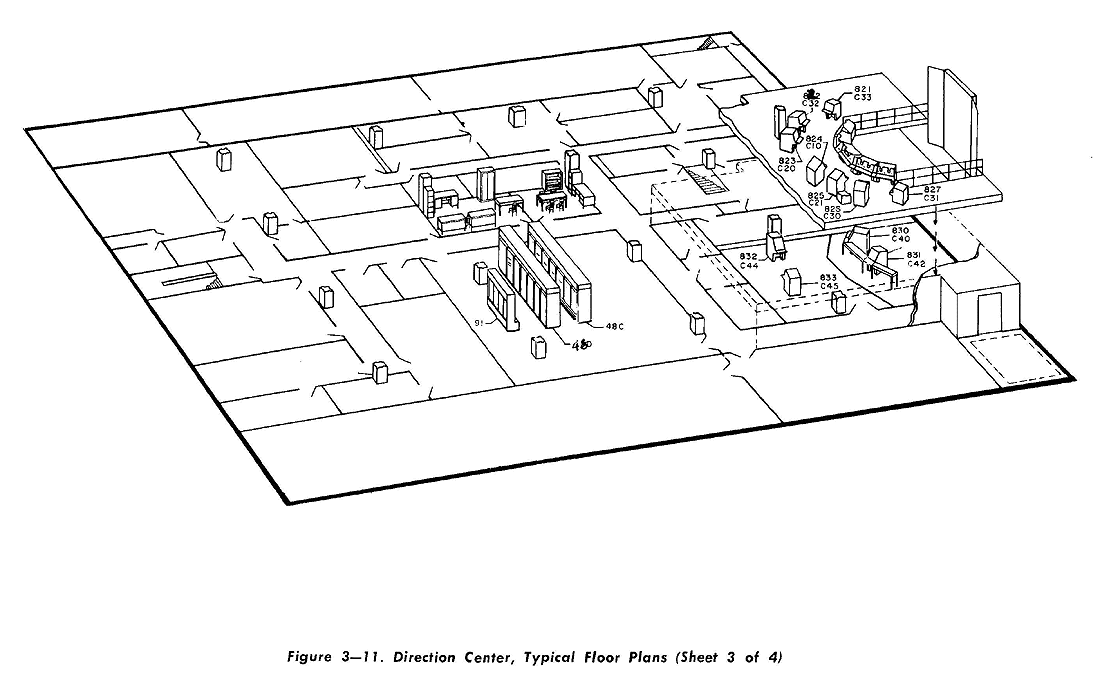


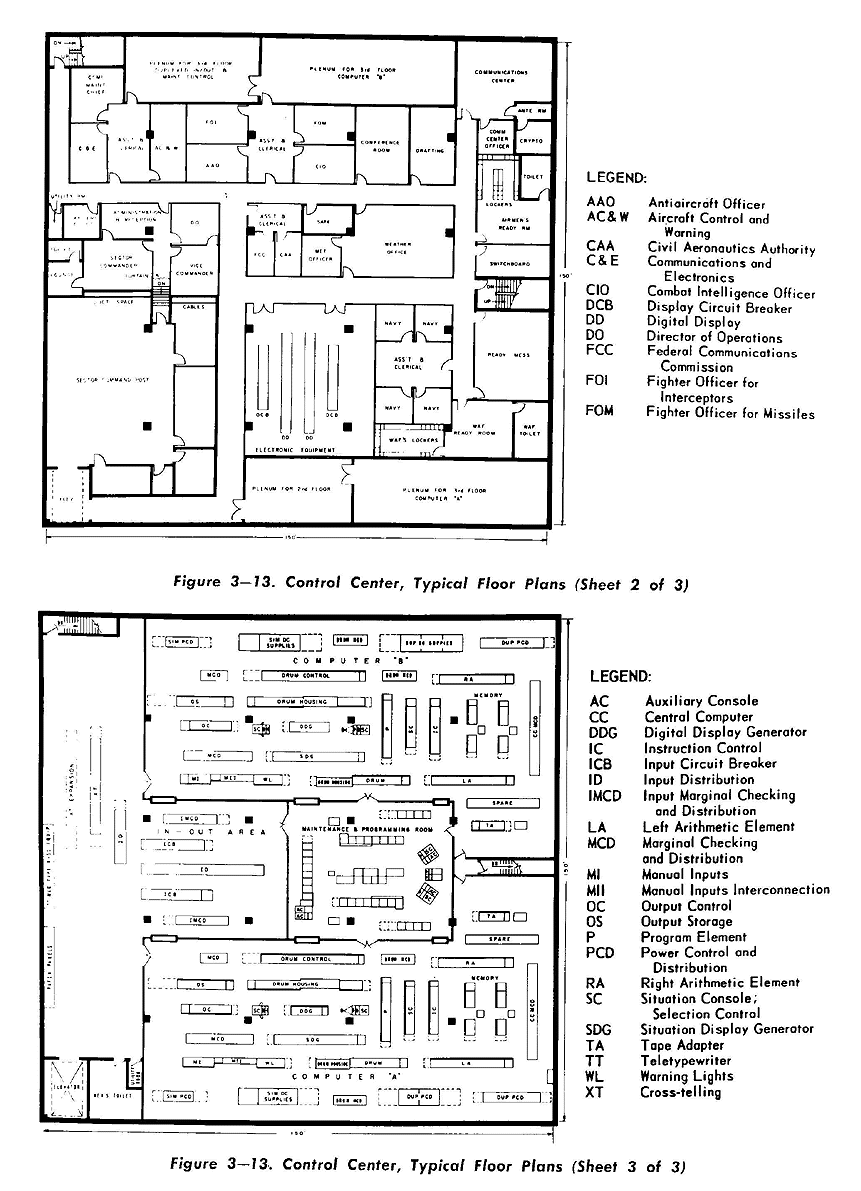
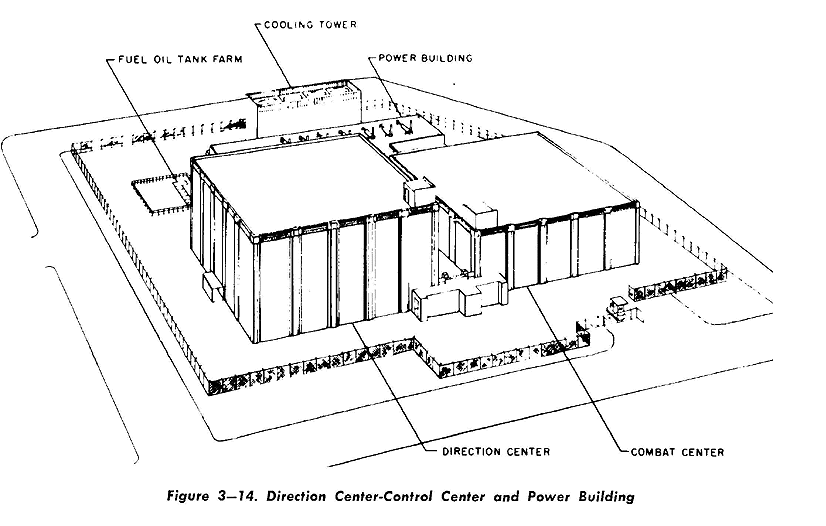
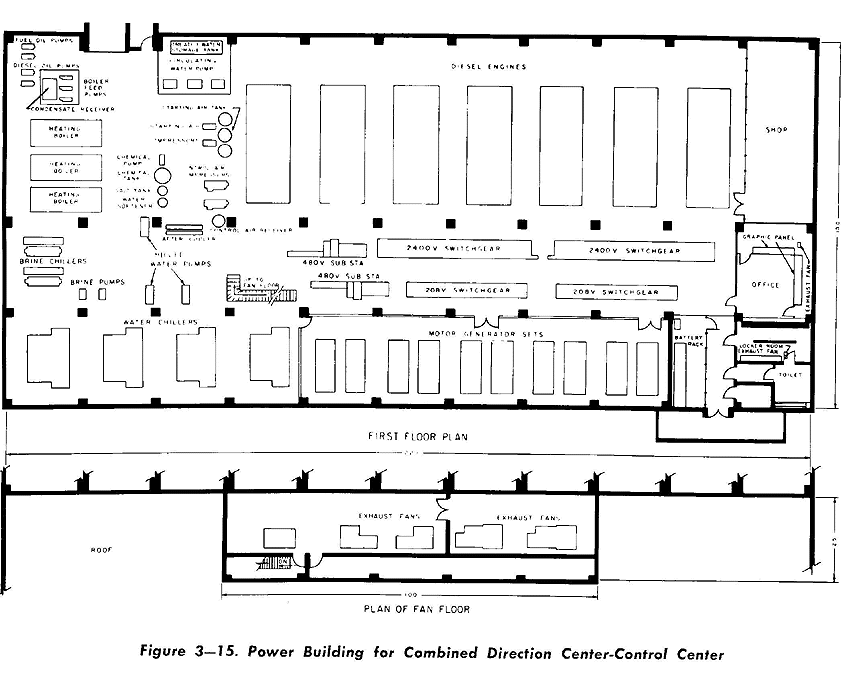
CHAPTER 4
RELIABILITY AND MAINTENANCE
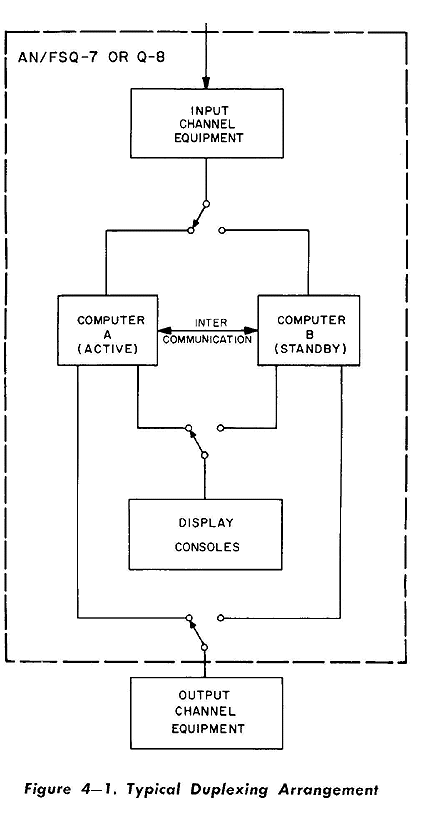
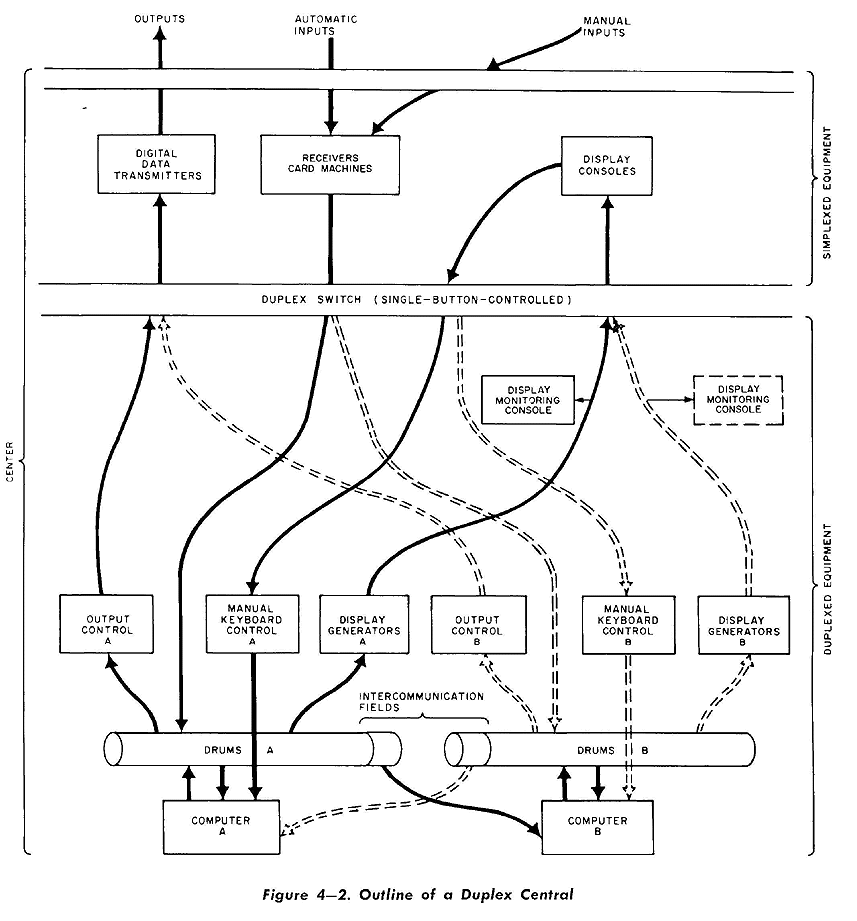
CHAPTER 5
MANUALS AND REFERENCE MATERIAL